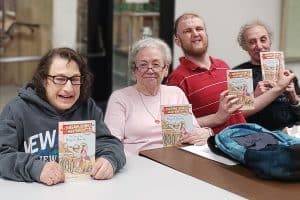
Agnes Rita, supervising librarian at Murrieta (Calif.) Public Library (MPL), had never planned a program series for adults with disabilities before, but she knew she wanted to start one—especially for those in the vocational groups that frequently visited her library.
“I had no experience but a lot of enthusiasm,” she told attendees of “Library for All: Programming Ideas for Adults with Disabilities on a $0 Budget,” a June 29 program at the American Library Association’s (ALA) 2024 Annual Conference and Exhibition in San Diego.
Thanks to her efforts, MPL has hosted 150 programs for adults with disabilities since 2018, with an average attendance of about 25–45 people. “Even when the library was closed [for COVID-19], we continued the program with take-home kits,” Rita said.
According to the Centers for Disease Control and Prevention, about one in four adults (27%) in the US has some type of disability. These can be visible or invisible, and can include physical, visual, and hearing disabilities; olfactory and gustatory conditions; somatosensory impairments; intellectual and developmental disabilities; and mental health and emotional disorders.
“When I was first starting out, I had to learn by asking,” said Rita, who recommends beginning with research. Libraries can gather community input by conducting strategic surveys and focus groups with potential participants and, when applicable, their coaches and caregivers. They can also ask questions on social media, look to other libraries for advice, and have in-person conversations with patrons in the library and at local resource fairs.
Not only does research help in shaping programs, Rita said, but also in considering accessibility and ADA compliance. “Evaluate your program space—this is the most important thing,” she said. At MPL, for instance, spaces for wheelchairs and other mobility devices are clearly marked on the floor with tape and located near exits.
It’s also vital to seek administrative and financial support for a program early, Rita noted. She recommended turning to Friends groups and foundations, nonprofit organizations, state libraries, and retail stores for grants and donations.
“When I first started, I had no budget,” said Rita, who initially borrowed craft supplies from her children’s services department. To get ideas for other no-cost and low-cost programs and professional development, Rita turned to such resources as Project Enable, Infopeople, WebJunction, Pinterest, YouTube, and ALA’s Programming Librarian website and interest groups.
Some of the most popular inclusive offerings at MPL have been activities that allow adults with disabilities to socialize together, such as field trips to visit the firehouse and city hall, bingo nights, karaoke parties, line dancing, oversized board games (“giant Jenga is their favorite,” Rita said), and sensory-friendly dance parties (“no strobe lights”).
To successfully market a program to adults with disabilities, Sandra Solache, MPL library assistant, recommends using the seven principles of universal design. This means prioritizing accessibility and inclusion in fliers and other materials by (among other best practices) using person-first language, an uncluttered layout with high contrast and a clear visual hierarchy, legible fonts, and multiple formats.
“Fliers are a powerful tool because they showcase our inclusivity,” said Solache. “[They make participants] feel like true library celebrities.”
In closing the program, Monica Chapa Domercq, advisor for the Pacific Library Partnership and trustee at Oceanside (Calif.) Public Library, explained a scale for evaluating a program’s equity (is participation restricted, or is the program open to everyone?), diversity (is one skill accommodated, or is everyone accommodated?), and inclusion (do you need to be cognitively independent and able-bodied to attend, or is the program adaptive and fully inclusive?).
Rita agreed with Chapa Domercq that reducing barriers for marginalized patrons helps everyone in the community.
“Programming for adults with disabilities should be a staple,” Rita said, “like how storytime programming is.”


